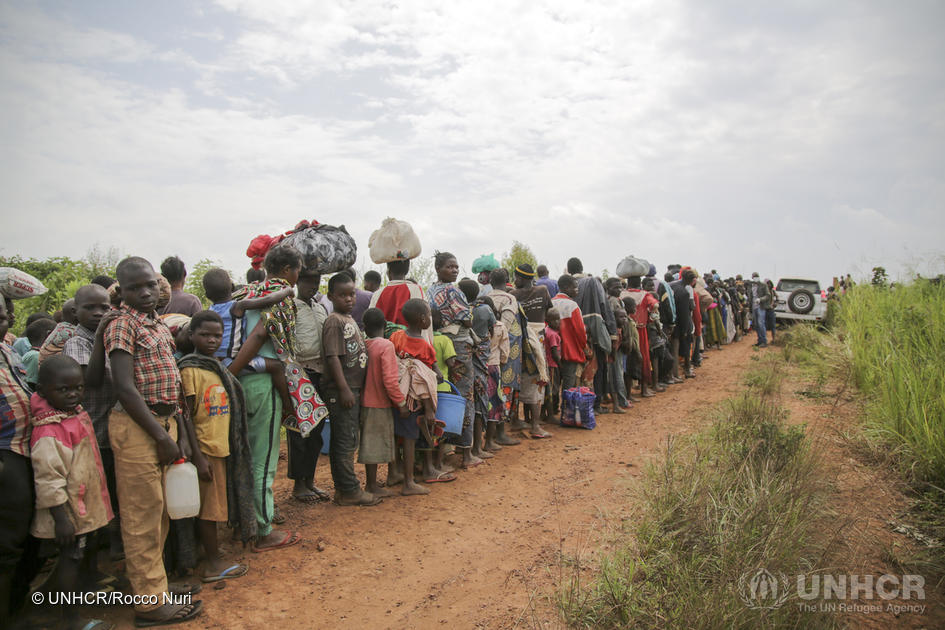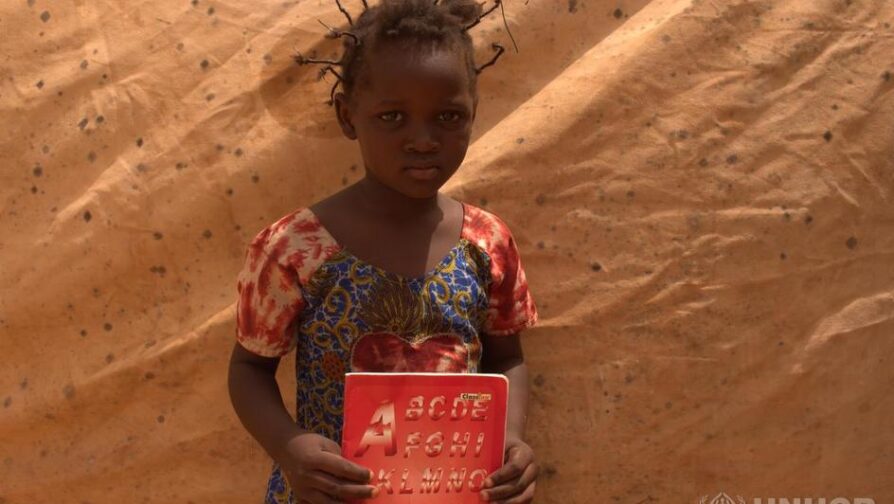
Congolese asylum-seekers line up to undergo security and health screening in Zombo, near the border between Uganda and the Democratic Republic of Congo. ; In July 2020, UNHCR, the Government of Uganda and partners mounted an emergency operation in the Zombo district to receive thousands of asylum-seekers stranded in no-man's land between Uganda and the Democratic Republic of the Congo (DRC) since late-May. The Guladjo and Mount Zeu border points have been opened for three days to receive civilians who are among an estimated 45,000 people displaced by militia violence in eastern DRC. Like many countries, Uganda closed its borders in March to contain the spread of COVID-19. Upon arrival at the border, all asylum-seekers underwent security and health screening. Vulnerable individuals were identified and fast-tracked for assistance. Mandatory 14-day quarantine and COVID-19 testing is being carried out at Zewdu Farm Institute, where arrivals are being registered and given food and basic aid.
UNHCR, the UN Refugee Agency, is today urging world leaders to step up their efforts to foster peace, stability and cooperation in order to halt and begin reversing nearly a decade-long trend of surging displacement driven by violence and persecution.
Despite the pandemic, the number of people fleeing wars, violence, persecution and human rights violations in 2020 rose to nearly 82.4 million people, according to UNHCR’s latest annual Global Trends report released today in Geneva. This is a further four per cent increase on top of the already record-high 79.5 million at the end of 2019.
The report shows that by the end of 2020 there were 20.7 million refugees under UNHCR mandate, 5.7 million Palestine refugees and 3.9 million Venezuelans displaced abroad. Another 48 million people were internally displaced (IDPs) within their own countries. A further 4.1 million were asylum-seekers. These numbers indicate that despite the pandemic and calls for a global ceasefire, conflict continued to chase people from their homes.
“Behind each number is a person forced from their home and a story of displacement, dispossession and suffering. They merit our attention and support not just with humanitarian aid, but in finding solutions to their plight.”
“While the 1951 Refugee Convention and the Global Compact on Refugees provide the legal framework and tools to respond to displacement, we need much greater political will to address conflicts and persecution that force people to flee in the first place,” said the UN High Commissioner for Refugees, Filippo Grandi.
Girls and boys under the age of 18 account for 42 per cent of all forcibly displaced people. They are particularly vulnerable, especially when crises continue for years. New UNHCR estimates show that almost one million children were born as refugees between 2018 and 2020. Many of them may remain refugees for years to come.
“The tragedy of so many children being born into exile should be reason enough to make far greater efforts to prevent and end conflict and violence,” said Grandi.
The report also notes that at the peak of the pandemic in 2020, over 160 countries had closed their borders, with 99 States making no exception for people seeking protection. Yet with improved measures – such as medical screenings at borders, health certification or temporary quarantine upon arrival, simplified registration procedures and remote interviewing, more and more countries found ways to ensure access to asylum while trying to stem the spread of the pandemic.
Serbia currently hosts some 5,500 refugees, asylum-seekers and migrants, 4,500 of whom are accommodated in the Government-run centres. While the movement of people seeking international protection continued during the pandemic, UNHCR notes with satisfaction that Serbia kept its borders open, continuing to show solidarity and commitment to their protection and inclusion. At the same time, housing solutions are implemented for the remaining, most vulnerable refugees from 1992-95 period as well as for IDPs and the remaining, small number of persons at risk of statelessness.
“Solutions require global leaders and those with influence to put aside their differences, end an egoistic approach to politics, and instead focus on preventing and solving conflict and ensuring respect for human rights,” said Grandi.

Malian refugee Zeinabou holds a school book in the shelter where she lives with her father Boubacar Albizu and her mother and sister in Ouallam camp, Niger. ; Boubacar and his family fled Menaka in Mali amid rising insecurity in the Sahel. Increasing attacks by armed groups and the threat of sexual violence forced the family to uproot and cross the border into neighbouring Niger. They left Menaka on a donkey cart early in the morning, leaving most of their belongings behind, and arrived in the border village of Tabounkor around midnight. From their they continued to Ouallam camp, where they were registered in December 2019, as attacks on the Nigerien armed forces intensified. Their journey brought trauma, as they saw dead bodies along the route. The family feel safe now and are receiving food assistance and shelter. Their older daughter Zeinabou is enrolled at the camp’s primary school and Boubacar has begun working as a tailor again.
UNHCR 2020 Global Trends Report – key data:
82.4 million people forcibly displaced globally (79.5 million in 2019) – 4 per cent increase
26.4 million refugees (26.0 million in 2019) including:
20.7 million refugees under UNHCR’s mandate (20.4 million in 2019)
5.7 million Palestine refugees under UNRWA’s mandate (5.6 million in 2019)
48.0 million internally displaced people (45.7 million in 2019)
4.1 million asylum-seekers (4.1 million in 2019)
3.9 million Venezuelans displaced abroad (3.6 million in 2019)
2020 is the ninth year of uninterrupted rise in forced displacement worldwide. Today, one per cent of humanity is displaced and there are twice as many forcibly displaced people than in 2011 when the total was just under 40 million.
More than two thirds of all people who fled abroad came from just five countries: Syria (6.7 million), Venezuela (4.0 million), Afghanistan (2.6 million), South Sudan (2.2 million) and Myanmar (1.1 million).
Vast majority of world’s refugees – nearly nine in 10 refugees (86 per cent) – are hosted by countries neighbouring crises areas and low- and middle-income countries. The Least Developed Countries provided asylum to 27 per cent of the total.
For the seventh year in a row, Turkey hosted the largest refugee population worldwide (3.7 million refugees), followed by Colombia (1.7 million, including Venezuelans displaced abroad), Pakistan (1.4 million), Uganda (1.4 million) and Germany (1.2 million).
Pending asylum applications globally remained at 2019 levels (4.1 million), but States and UNHCR collectively registered some 1.3 million individual asylum applications, one million fewer than in 2019 (43 per cent less).
Additional information / supporting multimedia materials:
UNHCR’s Global Trends report and an accompanying package of multimedia assets are available on our media page: https://www.unhcr.org/unhcr-global-trends-2020-media-page-60be2dd14. The report is subject to a worldwide embargo of no use before 0500 GMT on 18 June 2021.
Note:
UNHCR’s Global Trends report is released in parallel with its annual Global Report – https://reporting.unhcr.org/publications#tab-global_report (link will be live on 18 June) – which reports on UNHCR programmes and activities to address the needs of all who are forced to flee, as well as the world’s known stateless populations.
For more information:
In Serbia, Mirjana Milenkovski, [email protected], +381 63 275 154
In Geneva, Shabia Mantoo, [email protected], +41 79 337 76 50
In Europe, please consult the full list of UNHCR spokespeople here
Share on Facebook Share on Twitter